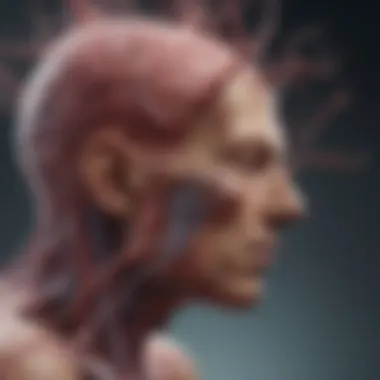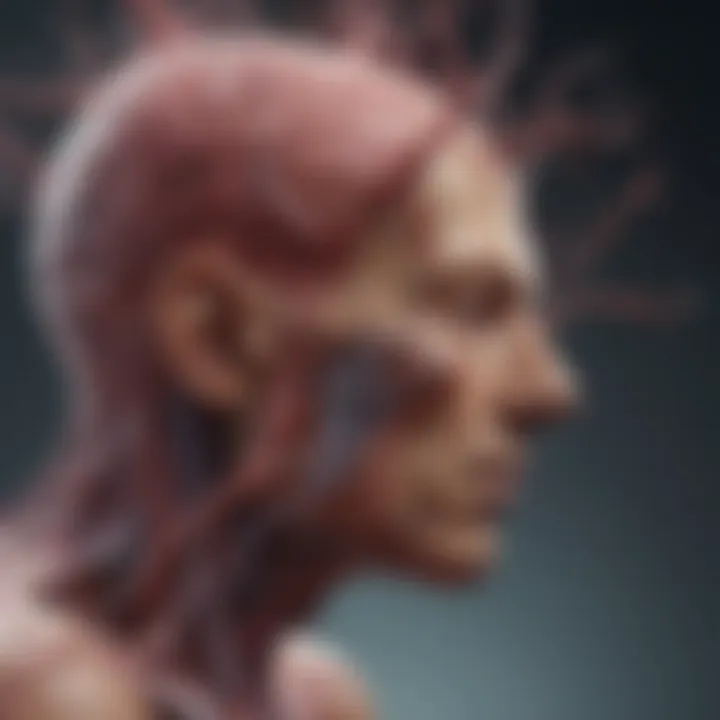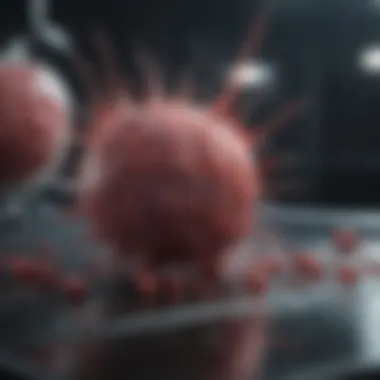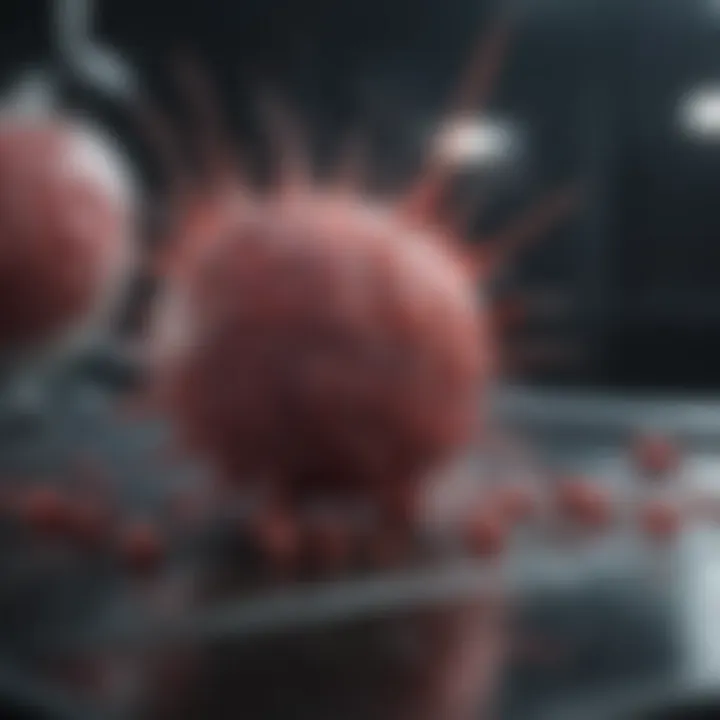Exploring Antiangiogenic Therapy: Mechanisms and Future


Intro
Antiangiogenic therapy represents a significant advancement in the treatment of various diseases, especially cancer. This approach focuses on disrupting the formation of new blood vessels, a process known as angiogenesis. The rationale is straightforward: tumors require a blood supply to grow and metastasize. By inhibiting angiogenesis, it is possible to starve tumors and reduce their ability to spread. This article aims to provide an extensive examination of the mechanisms underlying antiangiogenic therapy, explore its clinical applications, and discuss future directions in research and development.
Key Findings
Antiangiogenic therapy has gained attention due to its unique mechanism in cancer treatment. The therapy utilizes various agents, including monoclonal antibodies and small molecules, to target and inhibit the signaling pathways responsible for angiogenesis.
- Major Results: Recent studies highlight the effectiveness of drugs like Bevacizumab (Avastin) and Sunitinib (Sutent) in prolonging progression-free survival in patients with certain types of cancers, including colorectal and kidney cancers. These results emphasize the potential of antiangiogenic agents as a cornerstone in cancer therapy. However, treatment outcomes can vary significantly among individuals.
- Discussion of Findings: While there are promising results in terms of tumor growth inhibition, challenges remain. Resistance to antiangiogenic therapy is observed in a subset of patients, leading to a pressing need for ongoing research to understand these mechanisms better. Finding biomarkers to predict which patients will benefit from such therapies could improve outcomes.
Methodology
An effective understanding of the efficacy of antiangiogenic agents requires robust research methodologies.
- Research Design: Recent studies predominantly employ randomized controlled trials, which provide a strong foundation for assessing the clinical effectiveness and safety of the drugs. These trials typically include diverse populations to enhance the applicability of results across different patient demographics.
- Data Collection Methods: Data collection often involves a combination of clinical outcomes, patient-reported outcomes, and imaging studies. This multifaceted approach ensures a comprehensive understanding of the therapy's impact, not only on tumor size but also on patients' quality of life.
"Targeting angiogenesis holds the potential to revolutionize cancer treatment, offering new hope for patients facing aggressive diseases."
Prologue to Antiangiogenic Therapy
Antiangiogenic therapy represents a significant advancement in the realm of medical treatments aimed at obstructing the formation of new blood vessels, a process known as angiogenesis. This therapy is particularly vital as it addresses a fundamental mechanism associated with the progression of various diseases, most notably cancer. By inhibiting angiogenesis, it becomes possible to curtail tumor growth and metastasis, presenting an innovative approach in oncological therapies.
Understanding the importance of antiangiogenic therapy is crucial, especially in an era where precision medicine is becoming increasingly relevant. The necessity to explore treatments that are not only effective but also minimize adverse effects has sparked a growing interest in this area. This section lays the foundation for delving into the intricate mechanisms underlying antiangiogenic therapy while also highlighting its various applications across multiple medical fields.
Definition and Scope
Antiangiogenic therapy primarily refers to treatments designed to inhibit the formation of new blood vessels from pre-existing ones. This process is essential for tumor growth, as tumors require a continuous blood supply to receive nutrients and oxygen. Antiangiogenic agents are designed to target specific pathways involved in angiogenesis, thus effectively starving tumors or diseased tissues of necessary resources. The scope of antiangiogenic therapy extends beyond oncology, with applications in fields such as ophthalmology and inflammatory diseases.
The therapeutic agents in this category vary widely, encompassing monoclonal antibodies, small molecule inhibitors, and natural compounds, each targeting different aspects of the angiogenic process. The versatility of these agents allows for a tailored approach in managing multiple conditions, showcasing the broad implications of antiangiogenic therapies.
Historical Context
The historical backdrop of antiangiogenic therapy dates back to the early 20th century when the first observations linking tumor growth to new blood vessel formation were made. However, it wasn’t until the discovery of key angiogenic factors, particularly Vascular Endothelial Growth Factor (VEGF), in the late 20th century that this field began to gain traction. Research accelerated after the introduction of monoclonal antibodies, such as Bevacizumab, which specifically targets VEGF and has been utilized in treating several types of cancer.
Since then, the landscape of antiangiogenic therapy has evolved significantly. Numerous clinical trials have demonstrated both the effectiveness and challenges of these treatments, sparking ongoing research aimed at improving therapeutic strategies. The historical progression reveals a pattern of exploration and discovery, emphasizing the importance of continued investigation in enhancing the efficacy and application of antiangiogenic therapies in modern medicine.
"The potential of antiangiogenic therapy represents a critical front in the battle against diseases characterized by abnormal blood vessel growth."
By examining both the past and current state of this field, one can appreciate the impact that antiangiogenic therapy has had on the management of diseases, particularly cancer, and the necessity for continued research into its future applications.
Biological Mechanisms of Angiogenesis
Understanding the biological mechanisms of angiogenesis is crucial for evaluating the effectiveness of antiangiogenic therapies. Angiogenesis, the process of forming new blood vessels, plays a pivotal role in various physiological and pathological conditions. When this process becomes unregulated, as in tumors, it contributes to disease progression. Antiangiogenic therapy aims to target and disrupt this process, thus controlling disease outcomes. Gaining insight into these mechanisms allows researchers and clinicians to develop more targeted and efficient treatments, leading to improved patient outcomes.
The Angiogenic Process
The angiogenic process is a series of tightly regulated steps that involve the activation of endothelial cells, which line blood vessels. It begins with the degradation of the extracellular matrix, allowing endothelial cells to grow and migrate. Following this, endothelial cells proliferate and form tube-like structures, ultimately resulting in new capillary formation. Several signals prompt this process, including hypoxia, which leads to the expression of angiogenic factors. Monitoring these pathways provides insight into how to manipulate angiogenesis effectively in therapeutic contexts.


Key Angiogenic Factors
Multiple factors contribute to the angiogenic process. The primary angiogenic factors include Vascular Endothelial Growth Factor (VEGF), Fibroblast Growth Factor (FGF), and Platelet-Derived Growth Factor (PDGF). Each of these factors plays a distinct role in promoting angiogenesis, and understanding their individual mechanisms is essential for developing effective antiangiogenic therapies.
Vascular Endothelial Growth Factor (VEGF)
VEGF is a significant mediator in the angiogenic process. Its primary role is endothelial cell proliferation and permeability. Importantly, it elevates blood vessel formation in response to hypoxic conditions. Its key characteristic is that it specifically targets endothelial cells, making it a favored choice for therapies aiming at cancer treatment. VEGF's unique feature lies in its ability to stimulate vascular permeability, creating a nutrient-rich environment for tumor growth. While anti-VEGF therapies have shown promise, there is an ongoing challenge regarding resistance in patients, diminishing its long-term efficacy.
Fibroblast Growth Factor (FGF)
FGF is another pivotal factor involved in angiogenesis. It assists in the proliferation and survival of endothelial cells. FGFs are particularly beneficial in surgical wound healing and tissue regeneration. A notable aspect of FGF is its multifunctionality, as it also regulates cell differentiation and migration. This makes it a useful target for promoting angiogenesis when needed, such as in post-surgical recovery. However, excessive FGF activity can lead to unwanted angiogenesis, such as in cancers.
Platelet-Derived Growth Factor (PDGF)
PDGF plays a critical role not only in angiogenesis but also in recruiting pericytes, which are cells that stabilize blood vessels. PDGF is essential for forming mature and stable blood vessels. Its key characteristic is its ability to interact with multiple cell types, enhancing tissue repair processes. PDGF's unique feature is its involvement in the recruitment of supporting cells that strengthen existing blood vessels, making it crucial in chronic wound healing. However, its linkage to various cancers has raised concerns about its role in facilitating tumor growth as well.
Types of Antiangiogenic Agents
Understanding the various types of antiangiogenic agents is crucial for grasping how these therapies can be applied effectively. Each type has distinct mechanisms, benefits, and considerations that impact their use in clinical settings. This section will explore the most significant types of antiangiogenic agents, highlighting how they contribute to therapy outcomes across multiple medical conditions.
Monoclonal Antibodies
Monoclonal antibodies are engineered proteins that can specifically target and bind to certain antigens on cancer cells or other diseased tissues. In antiangiogenic therapy, antibodies like Bevacizumab (Avastin) are designed to inhibit the activity of Vascular Endothelial Growth Factor (VEGF). By blocking VEGF, these agents prevent the activation of signaling pathways that promote blood vessel formation. This is vital, as tumor growth often relies on angiogenesis to receive nutrients and oxygen.
The use of monoclonal antibodies in cancer treatment has shown substantial benefits, especially when used in combination with traditional chemotherapy. However, considerations include potential side effects. These may range from mild infusion reactions to more severe outcomes such as gastrointestinal perforations. Patients must be carefully monitored when receiving these therapies to manage potential adverse effects.
Tyrosine Kinase Inhibitors
Tyrosine kinase inhibitors (TKIs) are compounds that interfere with the activity of enzymes known as tyrosine kinases. These enzymes are involved in multiple cell signaling pathways, including those that regulate angiogenesis. Agents like Sorafenib and Sunitinib selectively target receptors associated with tumor angiogenesis. By inhibiting these pathways, TKIs reduce blood vessel formation, effectively starving the tumor.
The advantages of TKIs include oral administration and the ability to target multiple pathways simultaneously. However, like monoclonal antibodies, they come with challenges. Side effects can include hypertension and skin rashes, which can affect the patient's quality of life and, in some cases, require dose adjustments or treatment interruptions.
Small Molecule Inhibitors
Small molecule inhibitors represent another category of antiangiogenic agents. These compounds are typically administered orally and work by penetrating the cell membrane to interact with intracellular targets. Examples include Pazopanib and Axitinib, which inhibit pathways that promote angiogenesis at the cellular level.
These inhibitors offer a more versatile approach in conditions like advanced kidney cancer and certain sarcomas. The active targeting of specific enzymes involved in vascular growth offers a precision that can be more effective than broader-specific therapies. However, careful monitoring of liver function and other organ parameters is essential, as hepatotoxicity is a noted risk with some small molecule therapies.
Natural Compounds
Natural compounds are increasingly recognized for their antiangiogenic properties. Substances like curcumin, found in turmeric, and resveratrol in grapes have demonstrated potential to inhibit angiogenesis through multiple mechanisms, often with fewer side effects than synthetic drugs. These compounds are thought to affect multiple signaling pathways and offer a more holistic approach to treatment.
While promising, research into natural compounds is still in its infancy. More studies are necessary to determine optimal dosages, effectiveness, and potential interactions with conventional therapies. The use of natural compounds should be approached with caution, given the complexities of integrating them into established treatment protocols.
"The exploration of various antiangiogenic agents represents a broadening of strategies that aim to tackle challenging medical conditions, especially cancer."
In summary, each type of antiangiogenic agent presents unique opportunities and challenges. As researchers delve deeper into the mechanisms of these agents, the potential for improved treatment strategies continues to expand. Careful consideration of patient profiles, disease states, and side effect management remains essential for optimizing treatment outcomes.


Clinical Applications of Antiangiogenic Therapy
The exploration of clinical applications for antiangiogenic therapy holds significant relevance in contemporary medicine. This therapeutic strategy focuses on inhibiting neovascularization, which is crucial for tumor growth and progression as well as various retinal diseases. By understanding how to effectively apply antiangiogenic agents, healthcare professionals can enhance treatment outcomes across several medical fields, particularly oncology and ophthalmology.
Cancer Treatment
Solid Tumors
Solid tumors represent a major area where antiangiogenic therapy has been extensively utilized. These include malignancies such as breast, colorectal, and lung cancers. The key aspect of combating solid tumors involves targeting their vascular growth, which sustains their survival and expansion. Solid tumors generally exhibit a high degree of vascularization. By employing agents that inhibit angiogenesis, it is possible to reduce tumor nutrient supply, potentially leading to tumor regression. This method not only limits the growth of cancer cells but also can improve the effectiveness of other treatments like chemotherapy.
One notable characteristic of solid tumors is their heterogeneous microenvironment. This variability can affect the response to antiangiogenic therapy, making personalized approaches necessary. Although the benefits of such treatment are substantial, challenges remain, including the potential for hypoxia within tumors, which can lead to treatment resistance.
Hematological Malignancies
Hematological malignancies, including leukemia and lymphoma, also benefit from antiangiogenic strategies. In these conditions, targeting angiogenesis can help in disrupting the supportive networks that sustain malignant cells in the bone marrow and lymphatic system. A distinguishing feature of hematological malignancies is their reliance on the vascular niche for survival and proliferation. Antiangiogenic therapy aims to destabilize these microenvironments, reducing tumor burden and potentially enhancing patient outcomes.
However, the applicability of antiangiogenic agents in hematologic disorders can differ from solid tumors. The systemic circulation of blood cells can make it challenging to achieve targeted effects. This necessitates continued research to optimize drug delivery methods and maximize effectiveness.
Ophthalmology
Age-Related Macular Degeneration
Age-Related Macular Degeneration (AMD) is a leading cause of vision loss among older adults and presents a critical application for antiangiogenic therapy. The formation of new, abnormal blood vessels in the retina is a hallmark characteristic of this condition. Antiangiogenic agents have been shown to inhibit the growth of these vessels, subsequently protecting vision. This application is especially benefitical due to the selective targeting of pathological angiogenesis, which minimizes damage to healthy retinal tissue.
Furthermore, the unique feature of AMD treatments is the ability to administer them through localized injections, reducing systemic side effects. Nevertheless, the requirement for frequent treatments and the potential for adverse events highlight the need for ongoing improvement in therapeutic protocols.
Diabetic Retinopathy
Diabetic Retinopathy is another significant condition where antiangiogenic mechanisms have been employed with success. This disease is characterized by retinal changes due to diabetes, leading to abnormal blood vessel growth and vision impairment. The importance of targeting the vascular endothelial growth factor in this context that drives abnormal angiogenesis is essential. Antiangiogenic therapy in diabetic retinopathy has shown promising results in preserving vision and slowing disease progression.
However, while these treatments are effective, patient adherence to follow-up and treatment schedules can be challenging. This highlights the need for innovative solutions that simplify treatment regimens and enhance patient compliance.
Other Medical Conditions
Inflammatory Diseases
In the realm of inflammatory diseases, the role of antiangiogenic therapy is gaining attention. Conditions characterized by excessive blood vessel formation, such as rheumatoid arthritis, can potentially benefit from the use of these agents. The unique aspect of using antiangiogenic therapy here lies in its ability to reduce inflammation by targeting the vascular components that contribute to disease pathology.
Despite this potential, the variability in individual patient responses necessitates caution. Optimization of treatment plans tailored to specific inflammatory conditions is critical in enhancing overall efficacy.
Cardiovascular Disorders
Antiangiogenic approaches also apply to cardiovascular disorders. Diseases like atherosclerosis and heart failure show evidence that abnormal angiogenesis contributes to their pathology. Targeting angiogenesis in these contexts can help stabilize plaque and improve heart conditions by controlling vessel growth. The benefit of antiangiogenic therapy in cardiovascular contexts lies in its multifaceted approach to treatment.
Nonetheless, the potential systemic effects of antiangiogenic agents must be carefully monitored. Balancing therapeutic advantages with overall patient health remains a fundamental consideration.
In summary, the clinical applications of antiangiogenic therapy span diverse medical conditions with notable implications. Continued research into the mechanisms of action and patient-specific responses will further refine these therapeutic strategies.


Challenges and Limitations
Understanding the challenges and limitations associated with antiangiogenic therapies is crucial for comprehending their overall impact in clinical settings. These therapies have become prominent in the treatment landscape for a variety of diseases, particularly cancer. However, recognizing the hurdles also allows for a more nuanced approach towards improving treatment outcomes. This section elaborates on the efficacy of the treatment and the mechanisms of patient resistance which play a significant role in the success or failure of antiangiogenic therapies.
Treatment Efficacy
The efficacy of antiangiogenic treatment is often variable and can be influenced by multiple factors. In clinical trials, some patients experience considerable benefits, while others show minimal or no response. This inconsistency raises important questions about the effectiveness of these therapies. One prominent consideration is the selection of appropriate patient populations. Biomarkers can predict responses, yet identifying them remains challenging.
Moreover, factors such as the stage of disease, tumor microenvironment, and the specific angiogenic pathways utilized by tumors can impact treatment efficacy.solid tumors can respond differently compared to hematological malignancies. A solid tumor may depend heavily on vascular endothelial growth factor (VEGF), where targeting this factor can be more effective.
Furthermore, varying degrees of vascular normalization in patients complicate the situation. A well-functioning vasculature may not be receptive to antiangiogenic agents, whereas dysfunctional vessels may benefit more from therapy. Research needs to focus on improving patient selection and developing predictive models.
"The complex interplay of biological factors necessitates ongoing research to optimize treatment efficacy and personalize therapies."
Patient Resistance Mechanisms
Another profound challenge faced in antiangiogenic therapy is the emergence of patient resistance mechanisms. Tumors are remarkably adaptive and can develop strategies to evade therapeutic effects. Resistance can manifest as either innate or acquired mechanisms. Innate resistance refers to the initial lack of response to treatment, which can be attributed to the tumor's inherent properties, such as alternative growth factor pathways.
Acquired resistance occurs over time, often after an initial response to antiangiogenic agents. Tumors may adapt by upregulating alternative pathways or increasing levels of pro-angiogenic factors. For instance, if a tumor initially responds to VEGF inhibitors, it may later upregulate pathways involving fibroblast growth factors (FGFs).
The identification and understanding of these resistance mechanisms could facilitate the development of combination therapies. Targeting multiple pathways simultaneously may prevent or overcome resistance. Clinicians must remain vigilant and consider regular tumor assessments to adapt treatment strategies accordingly.
Ongoing Research and Future Directions
Ongoing research into antiangiogenic therapy is critical for advancing treatment options in various medical fields. This area is continually evolving due to the challenges and limitations currently faced in the clinic. There are substantial opportunities to enhance therapeutic outcomes through innovative methodologies and a deeper understanding of tumor biology. Emphasis on research helps identify more effective agents and combination therapies that can improve treatment efficacy.
Combination Therapies
Combination therapies represent a key focus in ongoing research within antiangiogenic treatment. The traditional use of antiangiogenic agents alone has shown limited success due to factors such as tumor heterogeneity and adaptive resistance mechanisms. By combining antiangiogenic drugs with other treatment modalities, such as chemotherapy, immunotherapy, or radiotherapy, researchers aim to develop more effective regimens.
For instance, the coupling of monoclonal antibodies targeting Vascular Endothelial Growth Factor (VEGF) with chemotherapy may enhance the overall anti-tumor effect. Studies are underway to examine various combination strategies to maximize patient outcomes.
Additionally, assessing the timing and sequencing of therapies is crucial. By intelligently designing treatment schedules, it may be possible to overcome resistance and increase treatment efficacy. Future investigations will need to focus on identifying the best combinations for specific cancer types and patient profiles.
Novel Drug Development
Novel drug development is another essential aspect of ongoing research in antiangiogenic therapy. This includes the exploration of new molecular targets and innovative drug designs. Current efforts are focused on developing agents that can effectively inhibit angiogenesis while minimizing side effects.
Research is also extending into the evaluation of small molecules and natural compounds that possess antiangiogenic properties. These agents may work through established pathways, or they may affect newer, less understood mechanisms. The potential for personalized medicine is particularly promising, as genetic and molecular profiling of tumors can lead to tailored therapies.
Moreover, advancements in technology, such as high-throughput screening and computational modeling, will facilitate the discovery of new compounds with antiangiogenic activity.
Ongoing research is vital to the future of antiangiogenic therapy, as it holds the promise of more effective treatments, improved patient outcomes, and a better understanding of complex biological processes.
The End
The conclusion section encapsulates the main insights gained from the exploration of antiangiogenic therapy. Understanding the mechanisms behind angiogenesis is crucial for appreciating how this therapy operates. By inhibiting the formation of new blood vessels, antiangiogenic therapy offers a targeted approach to treating various diseases, primarily cancer. The implications of this therapeutic strategy extend beyond oncology to ophthalmological conditions and other medical disorders.
Summary of Key Points
- Definition and Purpose: Antiangiogenic therapy aims to suppress angiogenesis, thereby limiting tumor growth and progression.
- Mechanisms: The biological processes that drive angiogenesis are complex, involving a range of key factors like Vascular Endothelial Growth Factor (VEGF) and Fibroblast Growth Factor (FGF).
- Types of Agents: Different antiangiogenic agents, including monoclonal antibodies and small molecule inhibitors, present various mechanisms of action and applications.
- Clinical Applications: The therapy has diverse applications, from treating solid tumors in cancers to addressing diseases like diabetic retinopathy.
- Challenges: Issues like treatment efficacy and patient resistance mechanisms highlight limitations.
- Future Directions: Research into combination therapies and novel drug development is essential for overcoming current hurdles and improving patient outcomes.
Implications for Future Research
Future research must focus on several key areas to enhance the efficacy and applicability of antiangiogenic therapies. Understanding resistance mechanisms more deeply will allow for the creation of more effective combination therapies. Furthermore, the exploration of novel antiangiogenic compounds could lead to groundbreaking treatments that provide better outcomes for patients. It is imperative to conduct clinical trials that assess the safety and effectiveness of these agents across various populations with distinct characteristics. This comprehensive approach will ensure that antiangiogenic therapy evolves to meet the ongoing challenges observed in clinical practice.



